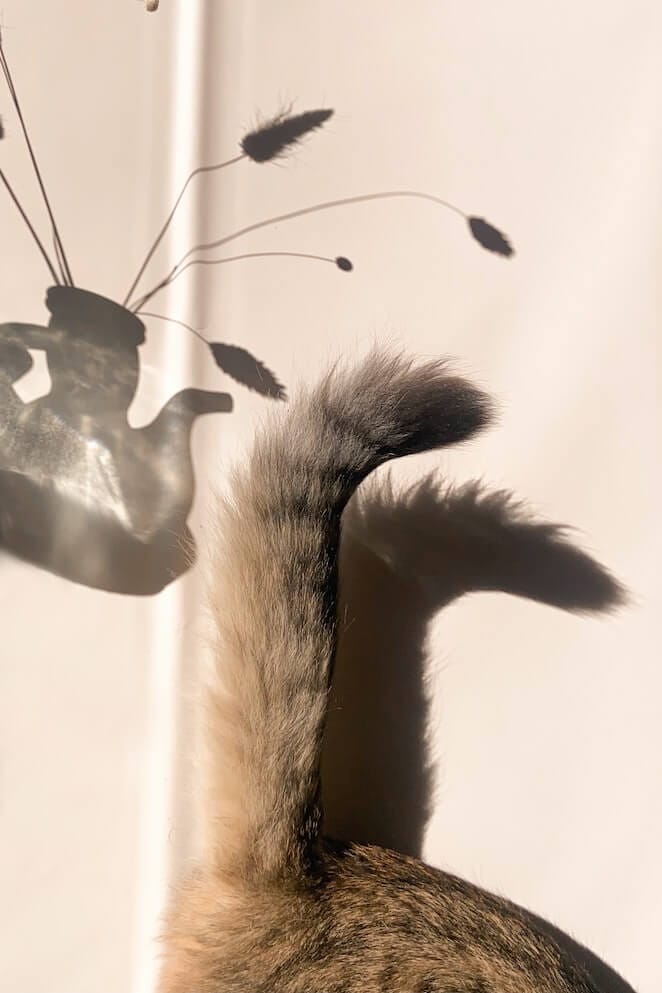
The cat’s tail is truly a wonder of nature, with its incredible flexibility and adaptability.
It can be used to express a variety of emotions, from joy and playfulness to displeasure and aggression.
The most impressive thing about the cat’s tail? Its ability to wag around in remarkable ways – from graceful curves to frantic whips!
We’ve seen cats perform some amazing feats with their tails, so if you ever get the chance, make sure you watch your feline friend’s tail carefully – you might just discover something new about this remarkable appendage!
Besides this, a cat’s tail holds a lot of mystery around it.
Let’s check out the top 10 facts about cat tails.
What is Special About a Cat’s Tail?

A cat’s tail can tell you more than just how curious they are. In fact, it is a veritable window into their soul!
By observing the way your feline friend swishes and sways its tail, you can gain insight into its moods and feelings. A happy kitty will have a relaxed, gently swaying tail.
An agitated one will be twitching or lashing back and forth. If your fur baby holds its tail low and tucked between its legs, something is definitely wrong and it may be feeling threatened or scared.
What is a cat’s tail made of?
A cat’s tails are made up of over 20 muscles that allow them to make all sorts of fancy shapes and maneuvers.
So when your kitty flicks its tail or wraps it around you, it’s not just trying to show off – it’s actually using those muscles for balance, communication and so much more!
Sometimes cats walk with their tail down to maintain posture.
The fur on a cat’s tail is just as soft and silky as the rest of its coat, so give it a good petting next time you have the chance. You’ll be sure to make your kitty purr with joy!
Top Facts About Cat Tails
Let us explore some interesting facts about cat tails:
Cat Tail Fact #1.
Did you know that cats have an average of 18 to 23 vertebrae in their tails? That’s more than twice the number found in human spines! This allows them to move their tails with amazing agility and flexibility.
Cat Tail Fact #2.
The tail position is important for cats when they’re on the prowl – by keeping their tails straight or slightly arched, they can help them stay balanced as they move quickly and silently through the underbrush looking for prey.
Cat Tail Fact #3.

The length and texture of a cat’s tail also vary depending on its breed. Siamese cats usually have shorter furrier tails, while the Manx, a rare cat breed, has no tail at all!
Cat Tail Fact #4.
While most cats use their tails for balance when jumping or climbing, their prehensile tails come in handy too. They can be used to grab onto things like branches and other objects.
Cat Tail Fact #5.
Cat tails aren’t just for show. They are highly sensitive organs covered with nerves and muscles that help them detect the slightest changes in air pressure and temperature around them.
Cat Tail Fact #6.
Tail-chasing is a common behavior among cats, particularly younger ones. By chasing their own tails they can release pent-up energy and stimulate their minds. It’s just like playing tag with themselves!
Cat Tail Fact #7.
Cats may even greet each other by touching noses or rubbing cheeks, but their tail is usually the first thing that makes contact when it comes to socializing.
Cat Tail Fact #8.
Believe it or not, cats actually have scent glands located at the base of their tails!
Not only do these glands help them leave a unique signature behind as they move around, but they also enhance other scents in their environment.
Cat Tail Fact #9.
Cat tails are great for storing fat reserves – which is why some cats look like they’re part squirrel when they’re healthy and well-fed!
It’s important to monitor your cat’s tail size because if it gets too skinny or thick, this could be an indication of underlying health issues.
Cat Tail Fact #10.
A cat’s tail can act as a heat regulator too – when it gets cold, the tail will wrap itself around itself to create an insulating layer that helps maintain body temperature.
So don’t be surprised if your cat uses its tail like a cozy blanket on chilly days!
Final Words

Cats may be mysterious creatures, but one thing is certain – they certainly have an interesting tail!
A cat’s tail is made up of bones, muscles, tendons, and ligaments, all covered with fur.
But it doesn’t stop there – cats also use their tails for a variety of purposes, from balance and communication to hunting and playing.
With so many uses for that bushy appendage, it’s no wonder cats are constantly twitching their tails!
So next time you see a cat swishing its tail around the house, remember there’s much more going on than meets the eye.
- 7 Dog Breeds With Webbed Feet And Why Do They Have Them - July 19, 2023
- 10 Best Fish For Small Tanks That Make Perfect Pets - July 18, 2023
- How to Breed Guinea Pigs: A Detailed Guide - July 17, 2023


GIPHY App Key not set. Please check settings